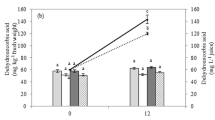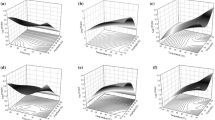Abstract
The impacts of ultraviolet-C radiation, blanching by heat, and combination of heat/ultrasounds (thermosonication) were studied for Listeria innocua (inoculated) in red bell peppers, total mesophiles in strawberries and total coliforms in watercress, in the temperature range 50–65 °C. Quality attributes such as colour and firmness were studied for all products, and total anthocyanins content was additionally determined for strawberries. Results showed that ultraviolet-C radiation was the least effective treatment in terms of microbial load reduction and was equivalent to a simple water washing. Log reductions were 1.05 ± 0.52 for L. innocua, 0.53 ± 0.25 for total coliforms and 0.26 ± 0.18 for total mesophiles. This treatment had the lowest impact on the quality parameters analysed. Thermosonication treatment was similar to heat blanching for all microorganism/product tested, excepted for total coliforms in watercress at 65 °C, in which thermosonication had a higher effect (p < 0.05). Heat blanching at 65 °C allowed 7.43 ± 0.12 log-cycles reduction, while loads were diminished by 8.24 ± 0.13 log-cycles if thermosonication at the same temperature was applied. Thermosonication also allowed better quality retention, when compared to heat blanching at the same temperatures. The impact of thermosonication on microbial load reductions was statistically significant and thermosonicated samples retained quality attributes better than heat blanched ones at the same temperatures (p < 0.05). Hence, it can be concluded that thermosonication is a promising process and may be a favourable alternative to the conventional thermal treatments.




Similar content being viewed by others
References
Ahvenainen, R. (1996). New approaches in improving the shelf life of minimally processed fruit and vegetables. Trends in Food Science & Technology, 7(6), 179–187.
Alegria, C., Pinheiro, J., Gonçalves, E. M., Fernandes, I., Moldão, M., & Abreu, M. (2009). Quality attributes of shredded carrot (Daucus carota L. cv. Nantes) as affected by alternative decontamination processes to chlorine. Innovative Food Science & Emerging Technologies, 10(1), 61–69.
Allende, A., & Artés, F. (2003a). UV-C radiation as a novel technique for keeping quality of fresh processed ‘Lollo Rosso’ lettuce. Food Research International, 36(7), 739–746.
Allende, A., & Artés, F. (2003b). Combined ultraviolet-C and modified atmosphere packaging treatments for reducing microbial growth of fresh processed lettuce. Lebensmittel-Wissenschaft und-Technologie, 36(8), 779–786.
Allende, A., Marín, A., Buendía, B., Tomás-Barberán, F., & Gil, M. I. (2007). Impact of combined postharvest treatments (UV-C light, gaseous O3, superatmospheric O2 and high CO2) on health promoting compounds and shelf-life of strawberries. Postharvest Biology and Technology, 46(3), 201–211.
Allende, A., McEvoy, J. L., Luo, Y., Artes, F., & Wang, C. Y. (2006). Effectiveness of two-sided UV-C treatments in inhibiting natural microflora and extending the shelf-life of minimally processed ‘Red Oak Leaf’ lettuce. Food Microbiology, 23(3), 241–249.
Anonymous (2000). Kinetics of microbial inactivation for alternative food processing technologies. Center for food safety and applied nutrition, U. S. Food and Drug Administration
Baumann, A. R., Martin, S. E., & Feng, H. (2005). Power ultrasound treatment of Listeria monocytogenes in apple cider. Journal of Food Protection, 68(11), 2333–2340.
Caminiti, I. M., Palgan, I., Muñoz, A., Noci, F., Whyte, P., Morgan, D. J., Cronin, D. A., & Lyng, J. G. (2010). The effect of ultraviolet light on microbial inactivation and quality attributes of apple juice. Food Bioprocess Technology, doi:10.1007/s11947-010-0365-x, in press.
Cao, S., Hu, Z., Pang, B., Wang, H., Xie, H., & Wu, F. (2010). Effect of ultrasound treatment on fruit decay and quality maintenance in strawberry after harvest. Food Control, 21(4), 529–532.
Char, C. D., Mitilinaki, E., Guerrero, S. N., & Alzamora, S. M. (2010). Use of high-intensity ultrasound and UV-C light to inactivate some microorganisms in fruit juices. Food Bioprocess Technology, 3, 797–803.
Cordenunsi, B. R., Nascimento, J. R. O., Genovese, M. I., & Lajolo, F. M. (2002). Influence of cultivar on quality parameters and chemical composition of strawberry fruits grown in Brazil. Journal of Agricultural and Food Chemistry, 50, 2581–2586.
Cruz, R. M. S., Vieira, M. C., & Silva, C. L. M. (2006). Effect of heat and thermosonication treatments on peroxidase inactivation kinetics in watercress (Nasturtium officinale). Journal of Food Engineering, 72(1), 8–15.
Cruz, R. M. S., Vieira, M. C., & Silva, C. L. M. (2007). Modelling kinetics of watercress Nasturtium officinalecolour changes due to heat and thermosonication treatments. Innovative Food Science & Emerging Technologies, 8(2), 244–252.
Cruz, R. M. S., Vieira, M. C., Fonseca, S. C., & Silva, C. L. M. (2009). Impact of thermal blanching and thermosonication treatments on watercress (Nasturtium officinale) quality: thermosonication process optimisation and microstructure evaluation. Food Bioprocess Technology, doi:10.1007/s11947-009-0220-0, in press.
D’Amico, D. J., Silk, T. M., Wu, J. R., & Guo, M. R. (2006). Inactivation of microorganisms in milk and apple cider treated with ultrasounds. Journal of Food Protection 69(3), 556–563.
Drlange (1994). Colour review. Drlange Application Report, No. 8. DrLange, USA.
Erkan, M., Wang, C. Y., & Krizek, D. T. (2001). UV-C irradiation reduces microbial populations and deterioration in Cucurbita pepo fruit tissue. Environmental and Experimental Botany, 45(1), 1–9.
Fonseca, J. M., & Rushing, J. W. (2006). Effect of ultraviolet-C light on quality and microbial population of fresh-cut watermelon. Postharvest Biology and Technology, 40(3), 256–261.
Gabaldón-Leyva, C. A., Quintero-Ramos, A., Barnard, J., Balandrán-Quintana, R. R., Talamás-Abbud, R., & Jiménez-Castro, J. (2007). Effect of ultrasound on the mass transfer and physical changes in brine bell pepper at different temperatures. Journal of Food Engineering, 81(2), 374–379.
Giese, N., & Darby, J. (2000). Sensitivity of microorganisms to different wavelengths of UV light: implications on modeling of medium pressure UV systems. Water Research, 34(16), 4007–4013.
Gil, M. I., Holcroft, D. M., & Kader, A. A. (1997). Changes in strawberry anthocyanins and other polyphenols in response to carbon dioxide treatments. Journal of Agricultural and Food Chemistry, 45, 1662–1667.
Giusti, M. M., & Wrolstad, R. E. (2001). Characterization and measurement of anthocyanins by UV-visible spectroscopy. Current protocols in food analytical chemistry, F1.2.1–F1.2.13.
Hernández, A. F., Robles, P. A., Gómez, P. A., Callejas, T. A., & Artés, F. (2010). Low UV-C illumination for keeping overall quality of fresh-cut watermelon. Postharvest Biology and Technology, 55, 114–120.
Keyser, M., Muller, I. A., Cilliers, F. P., Nel, W., & Gouws, P. A. (2008). Ultraviolet radiation as a non-thermal treatment for the inactivation of microorganisms in fruit juice. Innovative Food Science & Emerging Technologies, 9(3), 348–354.
Knorr, D., Zenker, M., Heinz, V., & Lee, D.-U. (2004). Applications and potential of ultrasonics in food processing. Trends in Food Science & Technology, 15(5), 261–266.
López-Rubira, V., Conesa, A., Allende, A., & Artés, F. (2005). Shelf life and overall quality of minimally processed pomegranate arils modified atmosphere packaged and treated with UV-C. Postharvest Biology and Technology, 37(2), 174–185.
Margolles, A., Mayo, B., & Reyes-Gavilán, C. G. (2000). Phenotypic characterization of Listeria monocytogenes and Listeria innocua strains isolated from short-ripened cheeses. Food Microbiology, 17(4), 461–467.
Marquenie, D., Michiels, C. W., Geeraerd, A. H., Schenk, A., Soontjen, C., Van Impe, J. F., & Nicoläi, B. M. (2002). Using survival analysis to investigate the effect of UVC and heat treatment on storage rot of strawberry and sweet cherry. International Journal of Food Microbiology, 73(2–3), 187–196.
Mason, T. J., Paniwnyk, L., & Lorimer, J. P. (1996). The uses of ultrasound in food technology. Ultrasonics Sonochemistry, 3(3), S253–S260.
Miller, F. A., Gil, M. M., Brandão, T. R. S., Teixeira, P., & Silva, C. L. M. (2009). Sigmoidal thermal inactivation kinetics of Listeria innocua in broth: Influence of strain and growth phase. Food Control, 20(12), 1151–1157.
Mukherjee, S., & Chattopadhyay, P. K. (2007). Whirling bed blanching of potato cubes and its effects on product quality. Journal of Food Engineering, 78(1), 52–60.
Noci, F., Walkling-Ribeiro, M., Cronin, D. A., Morgan, D. J., & Lyng, J. G. (2009). Effect of thermosonication, pulsed electric field and their combination on inactivation of Listeria innocua in milk. International Dairy Journal, 19(1), 30–35.
Pan, J., Vicente, A. R., Martínez, G. A., Chaves, A. R., & Civello, P. M. (2004). Combined use of UV-C irradiation and heat treatment to improve postharvest life of strawberry fruit. Journal of the Science of Food and Agriculture, 84(14), 1831–1838.
Piyasena, P., Mohareb, E., & McKellar, R. C. (2003). Inactivation of microbes using ultrasound: A review. International Journal of Food Microbiology, 87(3), 207–216.
Ross, A. I. V., Griffiths, M. W., Mittal, G. S., & Deeth, H. C. (2003). Combining nonthermal technologies to control foodborne microorganisms. International Journal of Food Microbiology, 89(2–3), 125–138.
Sotome, I., Takenaka, M., Koseki, S., Ogasawara, Y., Nadachi, Y., Okadome, H., & Isobe, S. (2009). Blanching of potato with superheated steam and hot water spray. LWT—Food Science and Technology, 42(6), 1035–1040.
Teow, C. C., Truong, V.-D., McFeeters, R. F., Thompson, R. L., Pecota, K. V., & Yencho, G. C. (2007). Antioxidant activities, phenolic and [beta]-carotene contents of sweet potato genotypes with varying flesh colours. Food Chemistry, 103(3), 829–838.
Tiwari, B. K., O’Donnell, C. P., & Cullen, P. J. (2009). Effect of sonication on retention of anthocyanins in blackberry juice. Journal of Food Engineering, 93(2), 166–171.
Unluturk, S., AtIlgan, M. R., Handan Baysal, A., & Tari, C. (2008). Use of UV-C radiation as a non-thermal process for liquid egg products (LEP). Journal of Food Engineering, 85(4), 561–568.
Vercet, A., Lopez, P., & Burgos, J. (1997). Inactivation of heat-resistant lipase and protease from Pseudomonas fluorescens by nanothermosonication. Journal of Dairy Science, 80(1), 29–36.
Vicente, A. R., Pineda, C., Lemoine, L., Civello, P. M., Martinez, G. A., & Chaves, A. R. (2005). UV-C treatments reduce decay, retain quality and alleviate chilling injury in pepper. Postharvest Biology and Technology, 35(1), 69–78.
Walpole, R. E., & Myers, R. H. (1993). Probability and statistics for engineers and scientists. New York, NY: Macmillan.
Yaun, B. R., Sumner, S. S., Eifert, J. D., & Marcy, J. E. (2004). Inhibition of pathogens on fresh produce by ultraviolet energy. International Journal of Food Microbiology, 90(1), 1–8.
Zenoff, V. F., Sineriz, F., & Farías, M. E. (2006). Diverse responses to UV-B radiation and repair mechanisms of bacteria isolated from high-altitude aquatic environments. Applied and Environmental Microbiology, 72(12), 7857–7863.
Acknowledgements
The authors acknowledge the financial support through Programa Operacional Agricultura e Desenvolvimento Rural—Projecto AGRO no. 822 (Novas Tecnologias de Processamento de Hortofrutículas Congelados—EMERCON). The authors Alexandre E.M.C., Santos Pedro, D.M.J. and Brandão T.R.S. would like to thank Fundação para a Ciência e a Tecnologia (grants SFRH/BD/16042/2004, SFRH/BPD/9174/2002 and SFRH/BPD/11580/2002, respectively).
Author information
Authors and Affiliations
Corresponding author
Rights and permissions
About this article
Cite this article
Alexandre, E.M.C., Santos-Pedro, D.M., Brandão, T.R.S. et al. Study on Thermosonication and Ultraviolet Radiation Processes as an Alternative to Blanching for Some Fruits and Vegetables. Food Bioprocess Technol 4, 1012–1019 (2011). https://doi.org/10.1007/s11947-011-0540-8
Received:
Accepted:
Published:
Issue Date:
DOI: https://doi.org/10.1007/s11947-011-0540-8




